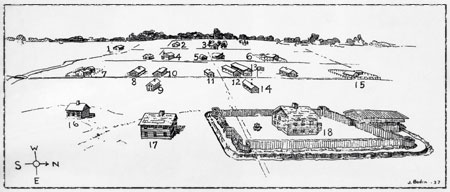General Information
It is fitting that Forest City, the site of so much of Meeker County history, should capture the essence of the Bicentennial spirit. It was here in 1855 that white men paddled and poled their way up the Crow River to the prairie just east of what later became Forest City. By 1856 new settlers had arrived and most of these arrivals took up claims, built log cabin homes, and cleared small tracts of land for cultivation. They also erected a sawmill and a flourmill. This was out of necessity, since the nearest market was in St. Paul, more than 65 miles away.
During this time, the Sioux had been firm friends for many years. However, unfair and dishonest treatment by government officials in the distribution of annuities and the breaking of treaty agreements had antagonized the Indians. They had made many futile attempts to collect the payments due them. Their leader, a general of great ability named Little Crow, called a secret meeting. Little Crow, speaking for hundreds of Indians said, "We have waited a long time. The money is ours, but we cannot get it. We have no food, but here are these stores, filled with food. We ask that you, the agent, make some arrangement by which we can get food from the stores, or else we may take our own way to keep from starving. When men are hungry they help themselves."
On August 17, 1862 the bitterness of six Indian braves boiled over. They killed five white settlers after a supposedly friendly shooting match in Acton...this marks the beginning of the Sioux Indian Uprising. It was followed by one skirmish after another, striking terror into the hearts of the brave pioneers. Forest City was the closest village and the county seat, so many of the settlers took their families there for safety. Others make the journey east to St. Anthony, which is now Minneapolis.
On August 23, 1862, arms and ammunition arrived from Governor Ramsey, and a military organization known as the "Home Guard" was formed that required all able-bodied men to report for duty. On September 3, 1862, members of the Home Guard and citizens of Meeker County hurriedly constructed the Stockade, which was completed within 24 hours. The Stockade provided security to hundreds of citizens of Meeker County during the Sioux Indian Uprising of 1862.
 A map showing the village of Forest City and Stockade in 1862. The illustration represents the townsite in its entirety and was produced from a pen and ink copy of a penciled drawing by H. Koener Strong, and executed by John Bodin of Dassel. The houses and buildings include: 1. Robinson, 2. Hoyt, 3. Heath, 4. A.C. Smithís shop, 5. Unknown, 6. Mailory, 7. Taylor, 8. Blacksmith shop, 9. Welles, 10. U.S. Land Office, 11. Shoemaker shop, 12. Hotel barn, 13. Atkinson Hotel, 14. Atkinsonís General Store, 15. Hamlet Stevens, 16. Schoolhouse, 17. T.C. Jewett, 18. Stockade.
A map showing the village of Forest City and Stockade in 1862. The illustration represents the townsite in its entirety and was produced from a pen and ink copy of a penciled drawing by H. Koener Strong, and executed by John Bodin of Dassel. The houses and buildings include: 1. Robinson, 2. Hoyt, 3. Heath, 4. A.C. Smithís shop, 5. Unknown, 6. Mailory, 7. Taylor, 8. Blacksmith shop, 9. Welles, 10. U.S. Land Office, 11. Shoemaker shop, 12. Hotel barn, 13. Atkinson Hotel, 14. Atkinsonís General Store, 15. Hamlet Stevens, 16. Schoolhouse, 17. T.C. Jewett, 18. Stockade.